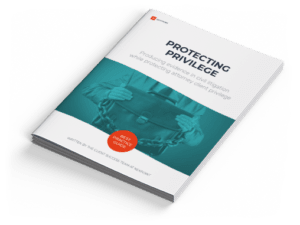Defending privileged documents in eDiscovery is not easy.
(See our recent post, “Why Lawyers Are So Bad at Protecting Privilege.”)
The right to private communication is vital to the practice of law, but, with the explosion of digital evidence in litigation, lawyers are finding it increasingly hard to protect every single piece of attorney-client work product. Unfortunately, the courts have consistently ruled that even the smallest slip-up or mistake that lets any piece of privileged data go to opposing counsel means your attorney client privilege is waived.
Lawyers have to prove that they made every possible effort to prevent privileged information from leaking, but, despite their best efforts, the information somehow got through. Or, to put in judge-speak, “When a producing party claims inadvertent disclosure, it has the burden of proving that the disclosure was truly inadvertent.” Fox v. Massey-Ferguson, Inc., 172 F.R.D. 653, 671 (E.D. Mich. 1995)
We’ve reviewed the most recent and evolving case law on the topic. As with any unsettled area of law, the rulings have been diverse and confusing. But a few common themes are becoming apparent. Here is the most relevant and recent case law on protecting privilege along with the specific advice from the courts on how to avoid a privilege disaster.
Make an Effort to Protect Attorney-Client Privilege
That may be good advice for anything in life, but it is also a specific command the courts have repeatedly delivered in privilege-related matters. Too often, lawyers produce evidence in litigation and, when they find out privileged information was given to opposing counsel, they try to get it back, arguing that the production was an accident.
There is a simple, three-part test to determine if a party waives privilege by accidentally producing to opposing counsel. Part one asks whether the production was truly an accident. The second and third parts of the test ask whether or not your team took reasonable efforts to prevent that disclosure from happening and then took steps to fix the problem once identified.
That means you have to demonstrate a concerted effort to protect privileged content but, for reasons out of your control, the data wound up in someone else’s hands. For example, the court in Pacific Coast Steel, Inc. v. Leany, No. 2:09-cv-12190-KJD-PAL, 2011 (D. Nev. Sept. 30, 2011) slapped down the plaintiff’s request to return privileged documents because he never made an effort to protect privilege.
The plaintiff in this employment matter tried to remove privileged documents from the evidence acquired by his former employer. However, the judge found that he had the opportunity to remove copies of his computer files, and did not make an effort to remove any of the confidential or privileged information, he “waived any privilege he may have had to privileged or confidential materials he left … by failing to take reasonable means to preserve the confidentiality of the privileged matter.”
Attorney-Client Privilege is Earned
The purpose of the attorney client privilege is to encourage clients to communicate freely with their attorneys. However, if your legal team doesn’t defend privilege, consider it waived. Case in point, Inhalation Plastics, Inc. v. Medex Cardio-Pulmonary, Inc., No. 2:07-CV-116, 2012 WL 3731483 (S.D. Ohio Aug. 28, 2012).
Here, the producing party, Medex, sent about 7,500 documents to the plaintiff and included 347 documents it had declared to be privileged. Medex attorneys tried to claim the production “was reviewed by several layers of attorneys who isolated the privileged documents.”
The court practically laughed that claim out of court, noting that “1 in approximately every 22 pages produced” was privileged, finding it impossible to believe the production was reviewed prior to delivery to opposing counsel. For that failure, privilege was waived.
Don’t Blame Your Vendor or Your Software
In Thorncreek Apartments III, LLC v. Village of Park Forest, 2011 2011 (N.D. Ill. Aug. 9, 2011), the defendants claimed to have screened documents for responsiveness and privilege before making them available.What actually happened is that the lawyers assumed that privileged documents would automatically be excluded from their production database.
They tried to blame their vendor and the database used for not removing privileged documents from the collection. The court held that it was their responsibility to check their database before releasing it to the plaintiff, calling this a “verification check… one would have expected the Village to perform.” Worst of all, the court found an “abject failure of the . . . process to protect allegedly privileged documents,” and that defendants “did not succeed in identifying and withholding from production even a single privileged document.”
Please, Pay Attention!
The most basic type of failure is when lawyers produce privileged documents and cannot show they made a good faith effort to prevent that production. In D’Onofrio v. Borough of Seaside Park, No. 09-6220 (AET), (D.N.J. May 30, 2012), the producing party had identified privileged documents, and had a plan in place to remove those from their production.
Unfortunately, the clerical worker who was asked to remove the privileged documents from the non-privileged documents reviewed less than half of all the data involved. Even worse, no one bothered to check that the clerk had properly done the job.
Protect Drafts and Attachments
Even Google failed to perform a thorough review for privileged documents. Google’s high-profile suit with Oracle turned into a draw, but the case itself pivoted on material from a draft email Google produced to opposing counsel. Several copies of the same draft email, in fact. Google included the final version of the email and one draft of the email on its privilege log but failed to identify eight auto-save drafts of the same email.
Google’s system for protecting privilege failed because Google’s privilege detection workflow looked for documents marked “Attorney Work Product” or were addressed to one of their lawyers, but was not sensitive enough to notice drafts that were substantially similar to the privileged documents. Google’s attempt to clawback the drafts was rejected and a Federal Circuit court upheld the ruling.
Similarly, in another Silicon Valley brawl, Ceglia v. Zuckerberg, an expert witness copied and produced a privileged email that was attached to another document. No one associated with the legal team supervised his actions, leading the court to waive any claims of privilege on the email. Hopefully the expert is better at testifying than handling sensitive documents.
Check Your Redactions, Too
Morgan Lewis & Bockius partner Joseph Floren became the poster child for this problem when his firm produced excerpts of emails written by Wall Street investment bank clients that were supposed to have been redacted as an attachment to a filing.
Keep a Detailed Privilege Log
One recurring theme in cases of privilege waiver is that many parties do not keep a complete privilege log. Keeping a privilege log is nothing more than creating a document that describes documents or other items withheld from production in a lawsuit because of attorney client privilege.
It can be a simple spreadsheet or Word document. But the lawyers in ePlus, Inc. v. Lawson Software, Inc., No. 3:09cv620 (E.D. Va) lost privilege for not accurately describing the documents they claimed as attorney-client work product. Judges frown on parties that produce documents and later decide they are privileged. But if your privilege log accurately describe specific pieces of privileged documents, it is easier to show courts exactly what documents you intend to keep confidential.
Don’t Count on a Clawback Agreement
In theory, clawback agreements allow parties to recover accidentally produced privileged documents. However, courts reject clawback agreements if parties do not take reasonable precautions to protect privilege, as in the case Mt. Hawley Ins. Co. v. Felman Production, Inc., S.D. W. Va. (May 18, 2010). The bottom line is, parties still need to show they took reasonable precautions to protect privilege if they want clawback agreements enforced.
Predictive Coding Will Not Magically Solve the Problem
Predictive coding is a hot topic in the legal field, but courts have yet to take a stand on how to best deploy the technology in litigation. However, as Greg Buckles at the eDiscovery Journal warns, the promise of machine learning technology doesn’t change privilege obligations. Lawyers need to integrate any new search technology they may deploy into their existing workflow and continue to maintain a detailed privilege log if they want to defend their rights.
Protecting privilege in the age of eDiscovery is still a complicated and confusing area of law. Privilege continues to be one of the single largest costs associated with civil litigation.
Nextpoint has introduced technology that addresses all of the challenges associated with the inadvertent production of privileged documents. It’s a better way to produce evidence – technology that combines machine learning technology algorithms and an easy-to-follow privilege workflow that lets any legal team, no matter how big your eDiscovery review challenge, protect privilege from inadvertent disclosure.
You can also download our free best practices guide for protecting privilege for more detailed information on the clawback provision and 10 helpful tips for keeping privileged information safe.








